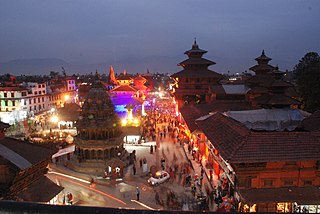List of monuments
| ID | Name | Type | Location | District | Coordinates | Image |
|---|---|---|---|---|---|---|
| NP-BT-01 | Bhaktapur Durbar Square | Bhaktapur Municipality | Bhaktapur | 27°40′19″N85°25′42″E / 27.6719841°N 85.4282648°E |  | |
| NP-BT-02 | Mulchok | Bhaktapur Municipality | Bhaktapur |  | ||
| NP-BT-03 | Maltichok | Bhaktapur Municipality | Bhaktapur |  | ||
| NP-BT-04 | Dvibhajuchok | Bhaktapur Municipality | Bhaktapur |  | ||
| NP-BT-05 | Kumarichok | Bhaktapur Municipality | Bhaktapur |  | ||
| NP-BT-06 | Bhandarkhal chok | Bhaktapur Municipality | Bhaktapur |  | ||
| NP-BT-07 | Lunhiti chok | Bhaktapur Municipality | Bhaktapur |  | ||
| NP-BT-08 | Janhachok | Bhaktapur Municipality | Bhaktapur |  | ||
| NP-BT-09 | Yamadwarchok | Bhaktapur Municipality | Bhaktapur |  | ||
| NP-BT-10 | Mahadevchok | Bhaktapur Municipality | Bhaktapur |  | ||
| NP-BT-11 | Bhairavchok | Bhaktapur Municipality | Bhaktapur |  | ||
| NP-BT-12 | Vaikwachok | Bhaktapur Municipality | Bhaktapur |  | ||
| NP-BT-13 | Nrityashwar choke | Bhaktapur Municipality | Bhaktapur |  | ||
| NP-BT-14 | Lakshmibilas choke | Bhaktapur Municipality | Bhaktapur |  | ||
| NP-BT-15 | Tunhtichok | Bhaktapur Municipality | Bhaktapur |  | ||
| NP-BT-16 | Jiswanchok | Bhaktapur Municipality | Bhaktapur |  | ||
| NP-BT-17 | Pachpanna Jhyale Darbar (55 Windows Palace) | Bhaktapur Municipality | Bhaktapur | 27°40′20″N85°25′41″E / 27.6722043°N 85.4279596°E |  (55 Windows Palace) | |
| NP-BT-18 | Lal Baithak | Bhaktapur Municipality | Bhaktapur | 27°40′20″N85°25′41″E / 27.6722043°N 85.4279596°E |  | |
| NP-BT-19 | Suvarnadwar | Bhaktapur Municipality | Bhaktapur | 27°40′19″N85°25′42″E / 27.6720761°N 85.4284103°E | 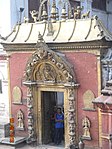 | |
| NP-BT-20 | Ganeshchok | Bhaktapur Municipality | Bhaktapur |  | ||
| NP-BT-21 | Dathuchok | Bhaktapur Municipality | Bhaktapur |  | ||
| NP-BT-22 | Bhairabnath Temple | Bhaktapur Municipality | Bhaktapur | 27°40′17″N85°25′42″E / 27.6714906°N 85.4284239°E |  | |
| NP-BT-23 | Temple of Salanganesh | Bhaktapur Municipality | Bhaktapur | 27°40′26″N85°26′06″E / 27.6739035°N 85.4350459°E |  | |
| NP-BT-24 | Salanganesh Dyo Chhe | Bhaktapur Municipality | Bhaktapur | 27°40′26″N85°26′06″E / 27.6739035°N 85.4350459°E |  | |
| NP-BT-25 | Wane Layaku | Bhaktapur Municipality | Bhaktapur | 27°40′19″N85°25′42″E / 27.6719225°N 85.4284717°E |  | |
| NP-BT-26 | Dattatreya Temple | Bhaktapur Municipality | Bhaktapur | 27°40′19″N85°25′42″E / 27.6719225°N 85.4284717°E |  | |
| NP-BT-27 | Narayan Mandir | Bhaktapur Municipality | Bhaktapur |  | ||
| NP-BT-28 | Bhimsen Temple | Bhaktapur Municipality | Bhaktapur |  | ||
| NP-BT-29 | Dhungedhara | Bhaktapur Municipality | Bhaktapur |  | ||
| NP-BT-30 | Nrityanath Temple (Nasha Dyo) | Bhaktapur Municipality | Bhaktapur | 27°40′27″N85°26′04″E / 27.6741012°N 85.4344222°E |  | |
| NP-BT-31 | Maheshwari Dyo Chhe | Bhaktapur Municipality | Bhaktapur |  | ||
| NP-BT-32 | Ganesh Dyo Chhe | Bhaktapur Municipality | Bhaktapur |  | ||
| NP-BT-33 | Indrasiddhi Vinayak | Bhaktapur Municipality | Bhaktapur |  | ||
| NP-BT-34 | Mahadev Temple | Bhaktapur Municipality | Bhaktapur |  | ||
| NP-BT-35 | Dhungedhara | Bhaktapur Municipality | Bhaktapur |  | ||
| NP-BT-36 | Temple of Umamaheshwar | Bhaktapur Municipality | Bhaktapur |  | ||
| NP-BT-37 | Dhungedhara | Bhaktapur Municipality | Bhaktapur |  | ||
| NP-BT-38 | Dhumawati | Bhaktapur Municipality | Bhaktapur |  | ||
| NP-BT-39 | Narayan Mandir | Bhaktapur Municipality | Bhaktapur |  | ||
| NP-BT-40 | Jangam Sattal | Bhaktapur Municipality | Bhaktapur |  | ||
| NP-BT-41 | Nyatapola (Natapol Dutra) | Bhaktapur Municipality | Bhaktapur | 27°40′17″N85°25′42″E / 27.6714906°N 85.4284239°E | 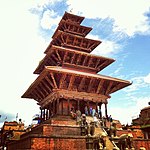 | |
| NP-BT-42 | Aisha - Marie Sattal (Aji Swanmadi) | Bhaktapur Municipality | Bhaktapur |  | ||
| NP-BT-43 | Temple of Bhairavnath | Bhaktapur Municipality | Bhaktapur | 27°40′19″N85°26′09″E / 27.6718343°N 85.4357404°E |  | |
| NP-BT-44 | Chatuwarna Mahavihar (Ta Dhi Chhe ) | Bhaktapur Municipality | Bhaktapur | 27°40′19″N85°25′45″E / 27.6719848°N 85.4291452°E |  | |
| NP-BT-45 | Hari Shankar Temple Sattal | Bhaktapur Municipality | Bhaktapur |  | ||
| NP-BT-46 | Shilu Mahadev | Bhaktapur Municipality | Bhaktapur |  | ||
| NP-BT-47 | Narayan Mandir | Bhaktapur Municipality | Bhaktapur |  | ||
| NP-BT-48 | Watsaladevi Temple (Nrityeshwari and Nrityanath) | Bhaktapur Municipality | Bhaktapur | 27°40′20″N85°25′39″E / 27.6721496°N 85.4276194°E | 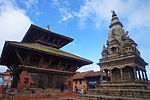 | |
| NP-BT-49 | Temple of Yaksheshwar | Bhaktapur Municipality | Bhaktapur | 27°40′20″N85°25′39″E / 27.6721496°N 85.4276194°E |  | |
| NP-BT-50 | Siddhilakshmi Temple | Bhaktapur Municipality | Bhaktapur | 27°40′19″N85°25′43″E / 27.6720093°N 85.4285277°E |  | |
| NP-BT-51 | Dhungedhara | Bhaktapur Municipality | Bhaktapur |  | ||
| NP-BT-52 | Bhuptindra Malla Statue | Bhaktapur Municipality | Bhaktapur | 27°40′19″N85°25′42″E / 27.6720761°N 85.4284103°E |  | |
| NP-BT-53 | Big Bell | Bhaktapur Municipality | Bhaktapur | 27°40′19″N85°25′41″E / 27.6718704°N 85.4280562°E |  | |
| NP-BT-54 | Rameshwar Temple | Bhaktapur Municipality | Bhaktapur | 27°40′20″N85°25′39″E / 27.6721496°N 85.4276194°E |  | |
| NP-BT-55 | Radha Krishna Temple | Bhaktapur Municipality | Bhaktapur |  | ||
| NP-BT-56 | Khauma Wahaa: and Santanu Wahaa? | Bhaktapur Municipality | Bhaktapur |  | ||
| NP-BT-57 | Jaldroni | Bhaktapur Municipality | Bhaktapur |  | ||
| NP-BT-58 | Godavari Math | Bhaktapur Municipality | Bhaktapur |  | ||
| NP-BT-59 | Chikanappa Math | Bhaktapur Municipality | Bhaktapur |  | ||
| NP-BT-60 | Sukuldoka Math | Bhaktapur Municipality | Bhaktapur |  | ||
| NP-BT-61 | Jangam Math | Bhaktapur Municipality | Bhaktapur |  | ||
| NP-BT-62 | Sithu Dathu and Tajaa Maths | Bhaktapur Municipality | Bhaktapur |  | ||
| NP-BT-63 | Pujari Math | Bhaktapur Municipality | Bhaktapur | 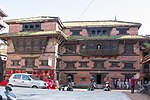 | ||
| NP-BT-64 | Pulanchotta Math | Bhaktapur Municipality | Bhaktapur |  | ||
| NP-BT-65 | Tilamadhav Narayan Temple | Bhaktapur Municipality | Bhaktapur | 27°40′15″N85°25′45″E / 27.6707508°N 85.4292423°E | 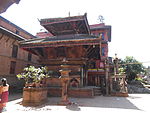 | |
| NP-BT-66 | MulGhar (Yachhe) | Bhaktapur Municipality | Bhaktapur |  | ||
| NP-BT-67 | Sikhwal Family Home | Bhaktapur Municipality | Bhaktapur |  | ||
| NP-BT-68 | Mahadevsthan | Bhaktapur Municipality | Bhaktapur |  | ||
| NP-BT-69 | Dhungedhara | Bhaktapur Municipality | Bhaktapur |  | ||
| NP-BT-70 | Balkumari | Bhaktapur Municipality | Bhaktapur | 27°40′13″N85°25′48″E / 27.6702534°N 85.4298795°E |  | |
| NP-BT-71 | Slanganesh Pokhari | Bhaktapur Municipality | Bhaktapur |  | ||
| NP-BT-72 | Dhungedhara | Bhaktapur Municipality | Bhaktapur |  | ||
| NP-BT-73 | Jangam Pati | Bhaktapur Municipality | Bhaktapur |  | ||
| NP-BT-74 | Bhote Baha | Bhaktapur Municipality | Bhaktapur |  | ||
| NP-BT-75 | Dhungedhara | Bhaktapur Municipality | Bhaktapur |  | ||
| NP-BT-76 | Dhungedhara | Bhaktapur Municipality | Bhaktapur |  | ||
| NP-BT-77 | Mahankal Bhaildyofalcha | Bhaktapur Municipality | Bhaktapur |  | ||
| NP-BT-78 | Chaitya (Chiba?) | Bhaktapur Municipality | Bhaktapur |  | ||
| NP-BT-79 | Golmadi Pati | Bhaktapur Municipality | Bhaktapur |  | ||
| NP-BT-80 | Narayan Mandir | Bhaktapur Municipality | Bhaktapur | 27°40′14″N85°25′44″E / 27.6706062°N 85.428844°E |  | |
| NP-BT-81 | Bhimsen Temple | Bhaktapur Municipality | Bhaktapur |  | ||
| NP-BT-82 | Naraynsthan | Bhaktapur Municipality | Bhaktapur |  | ||
| NP-BT-83 | Bulbul Hiti(Gupuhiti) | Bhaktapur Municipality | Bhaktapur |  | ||
| NP-BT-84 | Jaldenu (Balakhu) | Bhaktapur Municipality | Bhaktapur |  | ||
| NP-BT-85 | Jagannath Temple | Bhaktapur Municipality | Bhaktapur |  | ||
| NP-BT-86 | TripurasundarI Dyo Chhe | Bhaktapur Municipality | Bhaktapur |  | ||
| NP-BT-87 | Chaturnarayan | Bhaktapur Municipality | Bhaktapur |  | ||
| NP-BT-88 | Tripur Vidhyapith Agam | Bhaktapur Municipality | Bhaktapur |  | ||
| NP-BT-89 | Pahache Pati | Bhaktapur Municipality | Bhaktapur |  | ||
| NP-BT-90 | Walakhu Ganesh | Bhaktapur Municipality | Bhaktapur |  | ||
| NP-BT-91 | Shiva Temple | Bhaktapur Municipality | Bhaktapur |  | ||
| NP-BT-92 | Shiva Temple | Bhaktapur Municipality | Bhaktapur |  | ||
| NP-BT-93 | Kumari Temple | Bhaktapur Municipality | Bhaktapur | 27°40′13″N85°25′48″E / 27.6702534°N 85.4298795°E |  | |
| NP-BT-94 | Four Ganesh around Nyatapola | Bhaktapur Municipality | Bhaktapur | 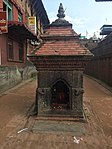 | ||
| NP-BT-95 | Umamaheshwar Sthan | Bhaktapur Municipality | Bhaktapur |  | ||
| NP-BT-96 | Lon Hiti and Navagraha | Bhaktapur Municipality | Bhaktapur |  | ||
| NP-BT-97 | Wetal Pati | Bhaktapur Municipality | Bhaktapur |  | ||
| NP-BT-98 | Dattatreya Temple | Bhaktapur Municipality | Bhaktapur |  | ||
| NP-BT-99 | Annapurna (Siddhilakshmi) | Bhaktapur Municipality | Bhaktapur |  | ||
| NP-BT-100 | Narayan Mandir | Bhaktapur Municipality | Bhaktapur |  | ||
| NP-BT-101 | Ganesh Temple | Bhaktapur Municipality | Bhaktapur |  | ||
| NP-BT-102 | Jaladhenu (Jaldroni) | Bhaktapur Municipality | Bhaktapur |  | ||
| NP-BT-103 | Temple of Umamaheshwar | Bhaktapur Municipality | Bhaktapur |  | ||
| NP-BT-104 | Wardali Math | Bhaktapur Municipality | Bhaktapur |  | ||
| NP-BT-105 | Bhimsen Sattal | Bhaktapur Municipality | Bhaktapur |  | ||
| NP-BT-106 | Vikalprasad Shrestha's Home | Bhaktapur Municipality | Bhaktapur |  | ||
| NP-BT-107 | Golden Karmacharya's Home | Bhaktapur Municipality | Bhaktapur |  | ||
| NP-BT-108 | Ashtalakshmi Shakya's Home | Bhaktapur Municipality | Bhaktapur |  | ||
| NP-BT-109 | Krishnagopal Joshi's Home | Bhaktapur Municipality | Bhaktapur |  | ||
| NP-BT-110 | Pu?vaha | Bhaktapur Municipality | Bhaktapur |  | ||
| NP-BT-111 | Sakulan Pati | Bhaktapur Municipality | Bhaktapur |  | ||
| NP-BT-112 | Inacho Pati | Bhaktapur Municipality | Bhaktapur |  | ||
| NP-BT-113 | Mahadevsthan | Bhaktapur Municipality | Bhaktapur |  | ||
| NP-BT-114 | TripurasundarI Pith | Bhaktapur Municipality | Bhaktapur |  | ||
| NP-BT-115 | Jaladroni Inar | Bhaktapur Municipality | Bhaktapur |  | ||
| NP-BT-116 | Gupuhiti | Bhaktapur Municipality | Bhaktapur |  | ||
| NP-BT-117 | Narasimha Temple | Bhaktapur Municipality | Bhaktapur |  | ||
| NP-BT-118 | Dabali (Bhimsen Dabali Nasmana Dabali and Taumadi Dabali) | Bhaktapur Municipality | Bhaktapur |  | ||
| NP-BT-119 | Bhubaneswari | Bhaktapur Municipality | Bhaktapur |  | ||
| NP-BT-120 | Chyamain Pavilion | Bhaktapur Municipality | Bhaktapur |  | ||
| NP-BT-121 | Itta Chapali (Sattal) | Bhaktapur Municipality | Bhaktapur |  | ||
| NP-BT-122 | Badrinath Temple | Bhaktapur Municipality | Bhaktapur | 27°40′20″N85°25′39″E / 27.6721496°N 85.4276194°E | 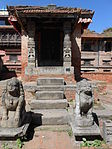 | |
| NP-BT-123 | Jagannath Temple | Bhaktapur Municipality | Bhaktapur |  | ||
| NP-BT-124 | Dhanavinayak Ganesh | Bhaktapur Municipality | Bhaktapur |  | ||
| NP-BT-125 | Dhungedhara | Bhaktapur Municipality | Bhaktapur |  | ||
| NP-BT-126 | Indrayani Temple (Dya Chhen) | Bhaktapur Municipality | Bhaktapur | 27°40′21″N85°25′37″E / 27.6723914°N 85.4269533°E |  | |
| NP-BT-127 | Uma Maheshwar | Bhaktapur Municipality | Bhaktapur |  | ||
| NP-BT-128 | Indrayni Pith | Bhaktapur Municipality | Bhaktapur |  | ||
| NP-BT-129 | Jhaurvahi (Dipankar Vihar) | Bhaktapur Municipality | Bhaktapur |  | ||
| NP-BT-130 | Narayan Mandir | Bhaktapur Municipality | Bhaktapur |  | ||
| NP-BT-131 | Narayan Mandir | Bhaktapur Municipality | Bhaktapur |  | ||
| NP-BT-132 | Guruju Priwarko Home | Bhaktapur Municipality | Bhaktapur |  | ||
| NP-BT-133 | Indraprasad Jhonchhe's Home | Bhaktapur Municipality | Bhaktapur |  | ||
| NP-BT-134 | Tulsibhakta Prdhananga's Home | Bhaktapur Municipality | Bhaktapur |  | ||
| NP-BT-135 | Dandapani Vaidya's Home | Bhaktapur Municipality | Bhaktapur |  | ||
| NP-BT-136 | Gopal Bhoju's Home | Bhaktapur Municipality | Bhaktapur |  | ||
| NP-BT-137 | Pitambar Karmacharya's Home | Bhaktapur Municipality | Bhaktapur |  | ||
| NP-BT-138 | Manandhar Priwar's Home | Bhaktapur Municipality | Bhaktapur |  | ||
| NP-BT-139 | Govind Malla including Mahesh Malla's Home | Bhaktapur Municipality | Bhaktapur |  | ||
| NP-BT-140 | Belbhakta Joshi's Home | Bhaktapur Municipality | Bhaktapur |  | ||
| NP-BT-141 | Shivprasad Vaidya's Home | Bhaktapur Municipality | Bhaktapur |  | ||
| NP-BT-142 | Mahendralal Yach's Home | Bhaktapur Municipality | Bhaktapur |  | ||
| NP-BT-143 | AshaRam Dwaju's Home | Bhaktapur Municipality | Bhaktapur |  | ||
| NP-BT-144 | Unknown Person's Home | Bhaktapur Municipality | Bhaktapur |  | ||
| NP-BT-145 | Hada Priwar's Home | Bhaktapur Municipality | Bhaktapur |  | ||
| NP-BT-146 | Radio Baje's Home | Bhaktapur Municipality | Bhaktapur |  | ||
| NP-BT-147 | Unknown Person's Home | Bhaktapur Municipality | Bhaktapur |  | ||
| NP-BT-148 | Unknown Person's Home | Bhaktapur Municipality | Bhaktapur |  | ||
| NP-BT-149 | Ratnraj Rajopadhya's Home | Bhaktapur Municipality | Bhaktapur |  | ||
| NP-BT-150 | Rajopadyays' Agamchhen | Bhaktapur Municipality | Bhaktapur |  | ||
| NP-BT-151 | Unknown Person's Home | Bhaktapur Municipality | Bhaktapur |  | ||
| NP-BT-152 | Baje's Home | Bhaktapur Municipality | Bhaktapur |  | ||
| NP-BT-153 | Siddha Pokhari (Ta Pukhu) | Bhaktapur Municipality | Bhaktapur | 27°40′18″N85°25′12″E / 27.6717055°N 85.4200514°E | 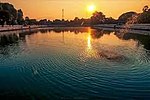 |













